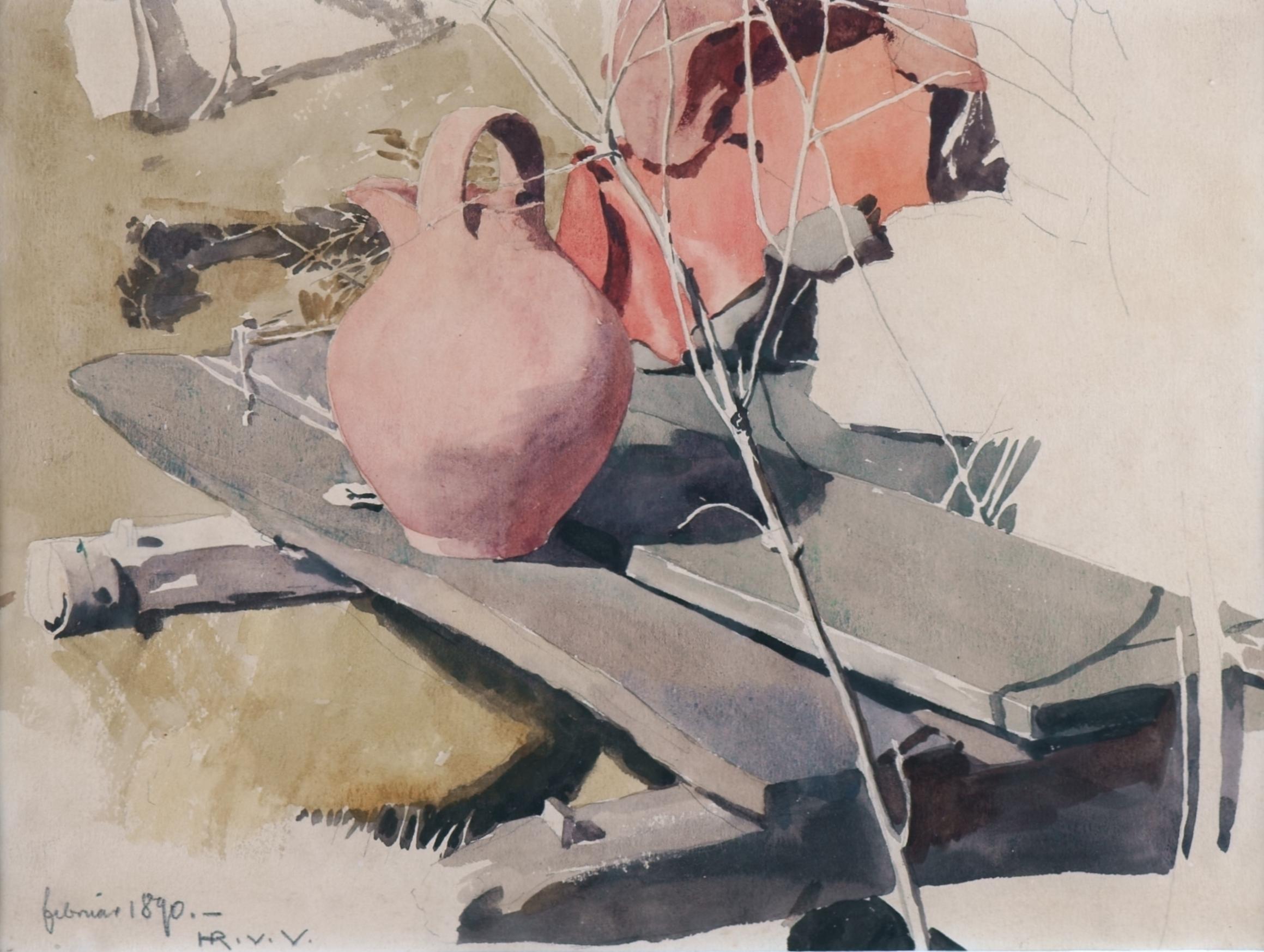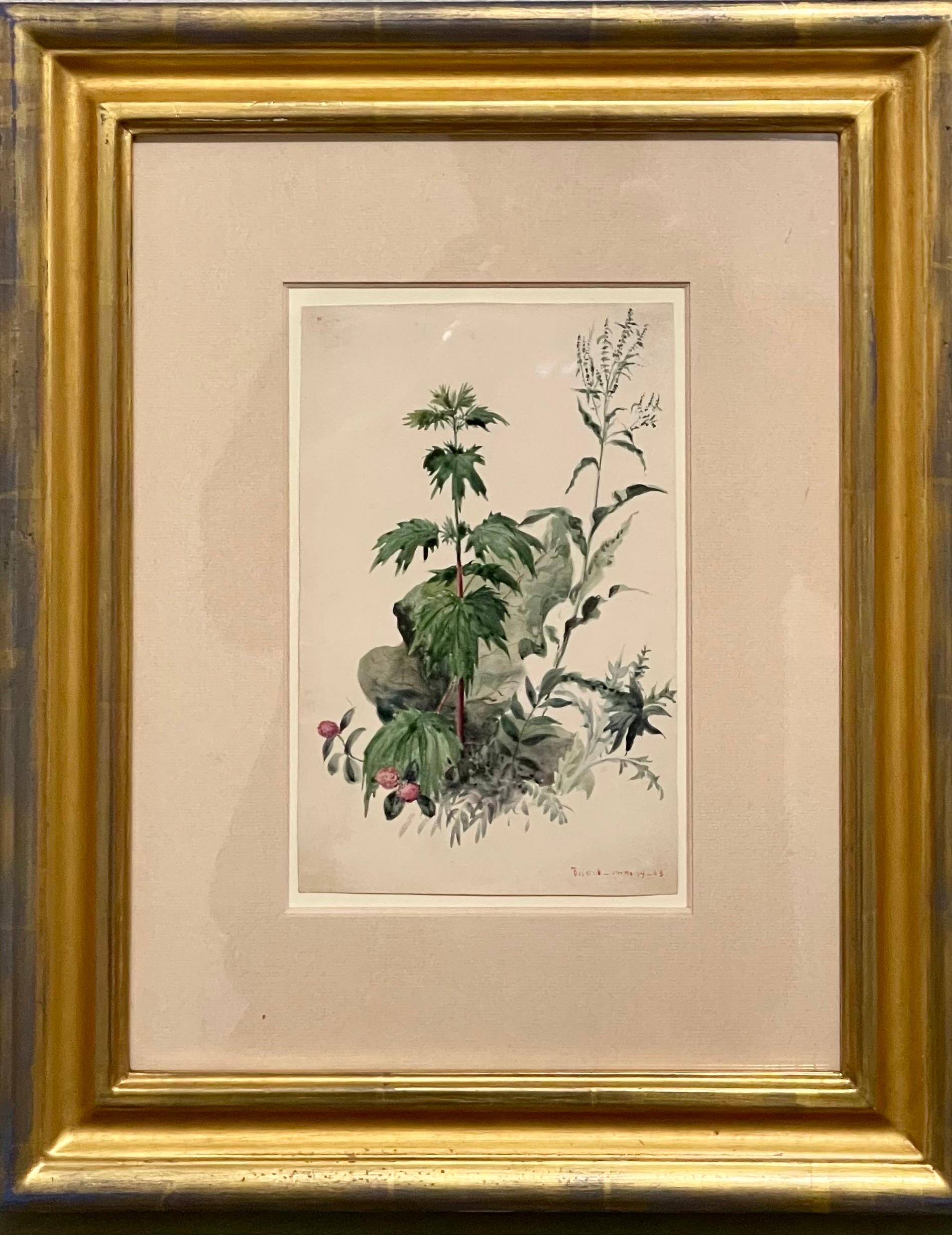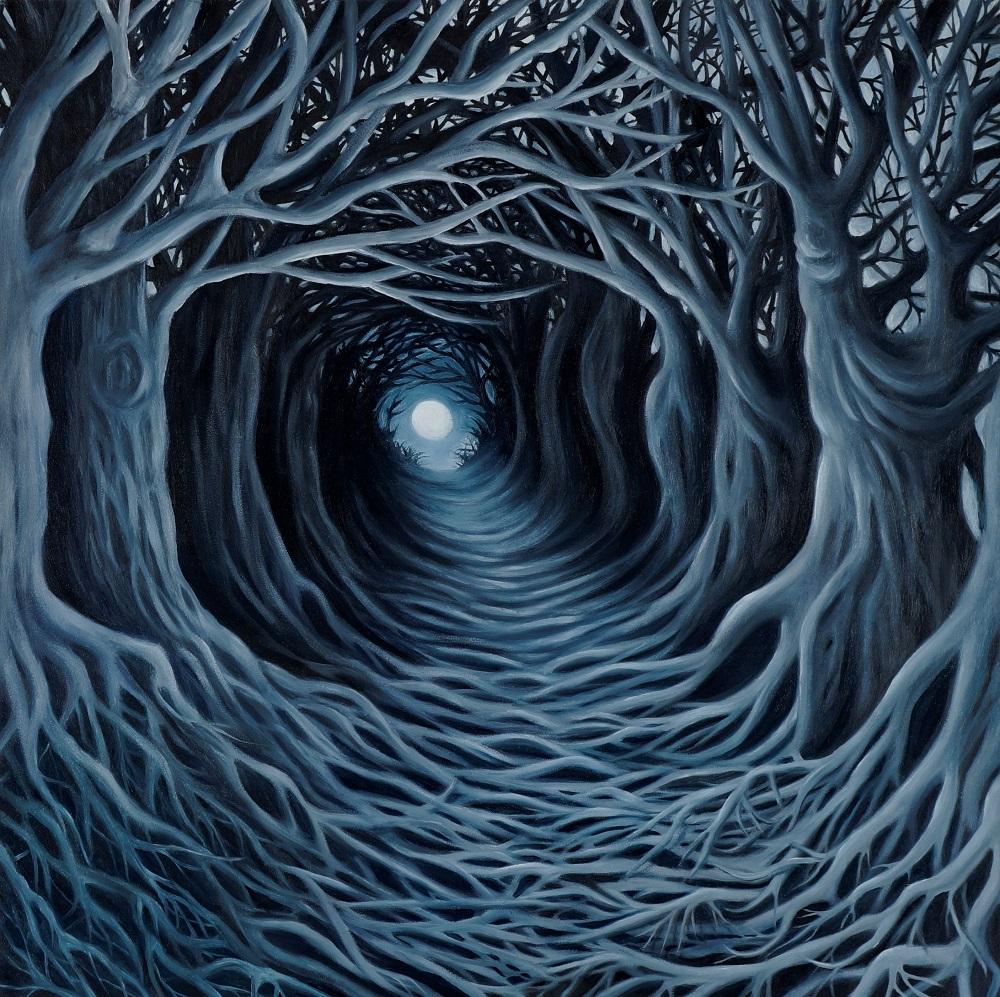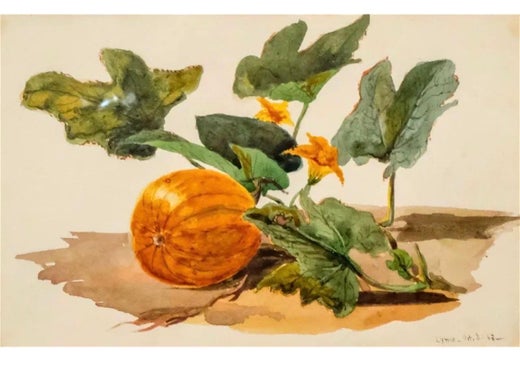Charles De Wolf BrownellPumpkin Vine Watercolor Painting 19th C. American Artist Charles DeWolf Brownell1868
1868
About the Item
- Creator:Charles De Wolf Brownell (1822 - 1909)
- Creation Year:1868
- Dimensions:Height: 9 in (22.86 cm)Width: 11.75 in (29.85 cm)
- Medium:
- Movement & Style:
- Period:
- Condition:good. mat has light wear.
- Gallery Location:Surfside, FL
- Reference Number:1stDibs: LU38210308422
Charles De Wolf Brownell
Charles De Wolf Brownell was born in Rhode Island in 1822 and grew up in Hartford, Connecticut. He studied law and pursued a career as a lawyer from 1843 to 1853. He abandoned his law practice after discovering his passion for landscape painting, which he realized during sketching trips he took with artist Henry Bryant in the Connecticut River Valley. He then trained with local artists Julius Theodore Busch and Joseph C. Ropes. In 1857, Brownell worked in a studio in Hartford and relocated to New York City in 1860. He became acquainted with Hudson River School painters, such as Frederic Church and John Frederick Kensett, and was quickly immersed into the New York art scene. He exhibited at the National Academy of Design in 1861, 1862, 1864 and 1865. In 1863, he exhibited at the Brooklyn Art Association, where he showed both American and Cuban landscapes. His work is represented in many public collections throughout the country, including the Wadsworth Atheneum, CT; the New Britain Museum of American Art, CT; and the Princeton University Art Museum, NJ.
(Biography provided by Driscoll Babcock Galleries)- ShippingRetrieving quote...Ships From: Surfside, FL
- Return PolicyA return for this item may be initiated within 3 days of delivery.
- Maple Leaves Watercolor Painting 19th C. American Artist Charles DeWolf BrownellBy Charles De Wolf BrownellLocated in Surfside, FLCharles De Wolf Brownell (American, 1822 - 1909) Watercolor on paper of maple leaves against the sky, Hand dated and inscribed "Papaw - E.H....Category
Early 1900s Naturalistic Landscape Drawings and Watercolors
MaterialsWatercolor
- Plants, Bristol 1863 Watercolor Painting American Artist Charles DeWolf BrownellBy Charles De Wolf BrownellLocated in Surfside, FLCharles De Wolf Brownell (American, 1822 - 1909) Watercolor on paper depicting several plants in close proximity Hand dated and inscribed "Br...Category
19th Century Naturalistic Landscape Drawings and Watercolors
MaterialsWatercolor
- Modern Polish Jewish Pencil Drawing Modernist LandscapeBy Jehudith SobelLocated in Surfside, FLJehudith Sobel (1924-2012 ) Polish/Jewish artist (also known as Judyta Sobel) Judith Sobel was born in Lwow, Poland in 1924. After Word War II she attended the Academy of Fine Arts in Lodz, Poland from 1947-1950, where she studied with the famous Abstract Constructivist, Wladyslaw Strzeminski and Stefan Wegner from whom she learned the principles of Modern Art as per the European Cubists. She was also part of the First Exhibit of Modern Art in Krakow in 1948/1949. From Poland she emigrated to Israel, where she exhibited and was collected by the major art museums of Israel including the Museum of Modern Art at Haifa. In 1956, Sobel came to New York on a scholarship and before that she lived in France for two years. Same year she received the First Prize at the Exhibition in the Saks Gallery...Category
1960s Modern Landscape Drawings and Watercolors
MaterialsPaper, Carbon Pencil
- Whimsical Illustration Hiking Cartoon, 1938 Mt Tremblant Ski Lodge William SteigBy William Steig (b.1907)Located in Surfside, FLLighthearted Illustration of Outdoor Pursuits This one being cross country hiking signed "W. Steig" Provenance: from Mrs. Joseph B. Ryan, Commissioned by Joe Ryan for the bar at his ski resort, Mount Tremblant Lodge, in 1938. Mont Tremblant, P.Q., Canada Watercolor and ink on illustration board, sights sizes 8 1/2 x 16 1/2 in., framed. In 1938 Joe Ryan, described as a millionaire from Philadelphia, bushwhacked his way to the summit of Mont Tremblant and was inspired to create a world class ski resort at the site. In 1939 he opened the Mont Tremblant Lodge, which remains part of the Pedestrian Village today. This original illustration is on Whatman Illustration board. the board measures 14 X 22 inches. label from McClees Galleries, Philadelphia, on the frame backing paper. William Steig, 1907 – 2003 was an American cartoonist, sculptor, and, in his later life, an illustrator and writer of children's books. Best known for the picture books Sylvester and the Magic Pebble, Abel's Island, and Doctor De Soto, he was also the creator of Shrek!, which inspired the film series of the same name. He was the U.S. nominee for both of the biennial, international Hans Christian Andersen Awards, as a children's book illustrator in 1982 and a writer in 1988. Steig was born in Brooklyn, New York in 1907, and grew up in the Bronx. His parents were Polish-Jewish immigrants from Austria, both socialists. His father, Joseph Steig, was a house painter, and his mother, Laura Ebel Steig, was a seamstress who encouraged his artistic leanings. As a child, he dabbled in painting and was an avid reader of literature. Among other works, he was said to have been especially fascinated by Pinocchio.He graduated from Townsend Harris High School at 15 but never completed college, though he attended three, spending two years at City College of New York, three years at the National Academy of Design and a mere five days at the Yale School of Fine Arts before dropping out of each. Hailed as the "King of Cartoons" Steig began drawing illustrations and cartoons for The New Yorker in 1930, producing more than 2,600 drawings and 117 covers for the magazine. Steig, later, when he was 61, began writing children's books. In 1968, he wrote his first children's book. He excelled here as well, and his third book, Sylvester and the Magic Pebble (1969), won the Caldecott Medal. He went on to write more than 30 children's books, including the Doctor DeSoto series, and he continued to write into his nineties. Among his other well-known works, the picture book Shrek! (1990) formed the basis for the DreamWorks Animation film Shrek (2001). After the release of Shrek 2 in 2004, Steig became the first sole-creator of an animated movie franchise that went on to generate over $1 billion from theatrical and ancillary markets after only one sequel. Along with Maurice Sendak, Saul Steinberg, Ludwig Bemelmans and Laurent de Brunhofff his is one of those rare cartoonist whose works form part of our collective cultural heritage. In 1984, Steig's film adaptation of Doctor DeSoto directed by Michael Sporn was nominated for the Academy Award for Best Animated Short Film. As one of the most admired cartoonists of all time, Steig spent seven decades drawing for the New Yorker magazine. He touched generations of readers with his tongue–in–cheek pen–and–ink drawings, which often expressed states of mind like shame, embarrassment or anger. Later in life, Steig turned to children's books, working as both a writer and illustrator. Steig's children's books were also wildly popular because of the crazy, complicated language he used—words like lunatic, palsied, sequestration, and cleave. Kids love the sound of those words even if they do not quite understand the meaning. Steig's descriptions were also clever. He once described a beached whale as "breaded with sand." Throughout the course of his career, Steig compiled his cartoons and drawings into books. Some of them were published first in the New Yorker. Others were deemed too dark to be printed there. Most of these collections centered on the cold, dark psychoanalytical truth about relationships. They featured husbands and wives fighting and parents snapping at their kids. His first adult book, Man About Town, was published in 1932, followed by About People, published in 1939, which focused on social outsiders. Sick of Each Other, published in 2000, included a drawing depicting a wife holding her husband at gunpoint, saying, "Say you adore me." According to the Los Angeles Times, fellow New Yorker artist Edward Sorel...Category
1930s Naturalistic Figurative Drawings and Watercolors
MaterialsArchival Ink, Watercolor, Illustration Board
- Whimsical Illustration Skiing Cartoon, 1938 Mt Tremblant Ski Lodge William SteigBy William Steig (b.1907)Located in Surfside, FLLighthearted Illustration of Outdoor Pursuits This one being a Skiing scene, a boy and a girl on skis. signed W. Steig Provenance: from Mrs. Joseph B. Ryan, Commissioned by Joe Ryan for the bar at his ski resort, Mount Tremblant Lodge, in 1938. Mont Tremblant, P.Q., Canada Watercolor and ink on illustration board, sights sizes 8 1/2 x 16 1/2 in., framed. In 1938 Joe Ryan, described as a millionaire from Philadelphia, bushwhacked his way to the summit of Mont Tremblant and was inspired to create a world class ski resort at the site. In 1939 he opened the Mont Tremblant Lodge, which remains part of the Pedestrian Village today. This original illustration is on Whatman Illustration board. the board measures 14 X 22 inches. label from McClees Galleries, Philadelphia, on the frame backing paper. William Steig, 1907 – 2003 was an American cartoonist, sculptor, and, in his later life, an illustrator and writer of children's books. Best known for the picture books Sylvester and the Magic Pebble, Abel's Island, and Doctor De Soto, he was also the creator of Shrek!, which inspired the film series of the same name. He was the U.S. nominee for both of the biennial, international Hans Christian Andersen Awards, as a children's book illustrator in 1982 and a writer in 1988. Steig was born in Brooklyn, New York in 1907, and grew up in the Bronx. His parents were Polish-Jewish immigrants from Austria, both socialists. His father, Joseph Steig, was a house painter, and his mother, Laura Ebel Steig, was a seamstress who encouraged his artistic leanings. As a child, he dabbled in painting and was an avid reader of literature. Among other works, he was said to have been especially fascinated by Pinocchio.He graduated from Townsend Harris High School at 15 but never completed college, though he attended three, spending two years at City College of New York, three years at the National Academy of Design and a mere five days at the Yale School of Fine Arts before dropping out of each. Hailed as the "King of Cartoons" Steig began drawing illustrations and cartoons for The New Yorker in 1930, producing more than 2,600 drawings and 117 covers for the magazine. Steig, later, when he was 61, began writing children's books. In 1968, he wrote his first children's book. He excelled here as well, and his third book, Sylvester and the Magic Pebble (1969), won the Caldecott Medal. He went on to write more than 30 children's books, including the Doctor DeSoto series, and he continued to write into his nineties. Among his other well-known works, the picture book Shrek! (1990) formed the basis for the DreamWorks Animation film Shrek (2001). After the release of Shrek 2 in 2004, Steig became the first sole-creator of an animated movie franchise that went on to generate over $1 billion from theatrical and ancillary markets after only one sequel. Along with Maurice Sendak, Saul Steinberg, Ludwig Bemelmans and Laurent de Brunhofff his is one of those rare cartoonist whose works form part of our collective cultural heritage. In 1984, Steig's film adaptation of Doctor DeSoto directed by Michael Sporn was nominated for the Academy Award for Best Animated Short Film. As one of the most admired cartoonists of all time, Steig spent seven decades drawing for the New Yorker magazine. He touched generations of readers with his tongue–in–cheek pen–and–ink drawings, which often expressed states of mind like shame, embarrassment or anger. Later in life, Steig turned to children's books, working as both a writer and illustrator. Steig's children's books were also wildly popular because of the crazy, complicated language he used—words like lunatic, palsied, sequestration, and cleave. Kids love the sound of those words even if they do not quite understand the meaning. Steig's descriptions were also clever. He once described a beached whale as "breaded with sand." Throughout the course of his career, Steig compiled his cartoons and drawings into books. Some of them were published first in the New Yorker. Others were deemed too dark to be printed there. Most of these collections centered on the cold, dark psychoanalytical truth about relationships. They featured husbands and wives fighting and parents snapping at their kids. His first adult book, Man About Town, was published in 1932, followed by About People, published in 1939, which focused on social outsiders. Sick of Each Other, published in 2000, included a drawing depicting a wife holding her husband at gunpoint, saying, "Say you adore me." According to the Los Angeles Times, fellow New Yorker artist Edward Sorel...Category
1930s Naturalistic Figurative Drawings and Watercolors
MaterialsArchival Ink, Watercolor, Illustration Board
- Small, Charming, Fauvist Painting Michel Henry French Modernist School of ParisBy Michel HenryLocated in Surfside, FLMichel-Henry was born in Langres in 1928 and has shown strong passion for drawing since his childhood. Michel-Henry is acknowledged as an important painter in French contemporary art. From 1952 his work has periodically been singled out for France's highest prizes and awards. The French Government, the City of Paris , the Museum of Valence , Bogota and the Museum of Alencon are among the distinguished institutions who have acquired his work for their permanent collections. Born in Langres in 1928 the aspiring artist attended the Ecole Nationale Superieure des Beaux-Arts in Paris. He later studied with Narbonne , Georg, Chapelain-Midy and Legueult. In 1957 he became a member of the House of Descartes in Amsterdam and the following year was named member of the Casa Velazquez in Madrid , honors which are exceptional for a young painter. He is a member of the Salon d'Automne as well as a member of its jury, he also exhibits in the Salon de la Société Nationale des Beaux-Arts, the Salon Comparisons, and the Salon Terres Latines. In 1976 he shared in the honor of presenting the Salon d'Automne exhibition in Japan . Michel-Henry blends delicate tones and strong and fascinating accents into his compositions of flower still life, landscapes and marines. An avid interest in nature is the predominant quality of his luminous works. As a French artist whose works are known internationally, Michel-Henry over a period of twenty eight years has earned the status of a goodwill ambassador in a universal world of cultural exchanges. For his dedication and unselfish contributions to art and artists from all lands he was honored by his country by being awarded the prestigious - la Croix de Chevalier de la Légion d'Honneur - on January 1, 1981 by the French Minister of Culture Mr. Jean Philippe Lecat. Michel Henry exhibited at prestigious galleries in Paris (Avenue Matignon) and New York (Madison Avenue) alongside such artists as Pablo Picasso, Fernand Leger, Armand Guillaumin, Maurice Utrillo and Claude Venard. He is part of School of Paris artists that included Marcel Cosson, Jean Jansem, Leni-Dael, Raoul Dufy, Claude Salomon, Michel Kouliche...Category
1960s Modern Still-life Paintings
MaterialsGouache, Paper
- Mademoiselle / botanical orchid watercolorBy Adrienne ShermanLocated in Burlingame, CA'Mademoiselle' is a sophisticated subdued, yellow and cream with green and brown still life orchid composition. The botanical watercolor created by a...Category
21st Century and Contemporary Naturalistic Still-life Drawings and Water...
MaterialsWatercolor, Archival Paper
- White Emblem Orchid / botanical watercolorBy Adrienne ShermanLocated in Burlingame, CAWhite Emblem Orchid featured in a sophisticated monochromatic grey indigo botanical watercolor crated by artist Adrienne Sherman. Her poetic floral series is at once modern, fresh an...Category
21st Century and Contemporary Naturalistic Still-life Drawings and Water...
MaterialsWatercolor, Archival Paper
- Clay jug on a bench - The essence of the clay jar revealed by the sunlight -By Hans Richard von VolkmannLocated in Berlin, DEHans Richard von Volkmann (1860 Halle (Saale) - 1927 ibid.), Clay jug on a bench. Pencil and Watercolour on paper. 20 x 26,7 cm (visible size), 37 x 45 cm (frame), dated and monogrammed lower left "Februar 1890 - HR. V. V." - Minimally tanned. Framed behind glass in a passepartout. About the artwork Using the technique of his early youth - pencil and watercolour - Hans Richard von Volkmann depicts a still life. However, this is not a conventional indoor still life, but an open-air depiction, painted outdoors and not in the studio. It is therefore an open-air painting, characteristic of von Volkmann's oeuvre, which could have been painted in the Willingshausen colony of painters, where open-air painting was programmatically practised there and the artist stayed there that year. And indeed, this painting is a manifesto of open-air painting. Von Volkmann demonstrates that leaving the studio for the light of nature leads to an entirely new quality of art. To prove this, he uses the genre of still life, which can be described as the studio subject par excellence. Moreover, light plays an essential role in the classical still life. It is the real protagonist of the still life. And it is precisely this moment, essential to the still life, that von Volkmann exploits to demonstrate the potential of plein-air painting: He presents the objects as they appear in the sunlight. The date of February and the bare branches in the foreground make it clear that this is a clear winter day in bright sunlight. The delicate plant in the foreground casts a clearly defined shadow, as does the jug. However, the shadow is most pronounced on the jug itself: The underside of the handle appears almost black, making the top, and therefore the jug itself, shine all the more brightly. The shining of the objects in the sunlight is also visible on the bench. As complementary phenomena to the shadow zones, light edges can be seen on the boards of the seats and the upper foot of the bench shines entirely in the light. To achieve this intensity of light, von Volkmann activated the bright white of the painting ground. By depicting the objects in glistening sunlight, von Volkmann demonstrates that this quality of light is only to be found outdoors. And this light leads to a new way of looking at the objects themselves. The jug on the bench seems like an accidental arrangement, as if the artist had stumbled upon this unintentional still life and captured it with fascination. And in this fascination there is a moment of realisation that refers to the objects themselves. It is only when they shine brightly in the sunlight that their true nature is revealed. In this way, sunlight allows the objects to come into their own, so to speak. Sunlight, which is not present in the studio, gives the still life an entirely new dimension of reality, which is also reflected in the colours interwoven by the sunlight: The bench and the jug stand in a harmonious grey-pink contrast to the green of the implied meadow. The emphasis on the jug as the central subject of the picture also implies that the watercolour has not been completed. This non finito inscribes a processuality into the picture, making it clear that something processual has been depicted, the temporality of which has been made artistically permanent. This is why von Volkmann signed the painting and dated it to the month. About the Artist Von Volkmann made his first artistic attempts at the age of 14. He painted many watercolours of his home town of Halle. This laid the foundation for his later outdoor painting. In 1880 his autodidactic beginnings were professionalised with his admission to the Düsseldorf Art Academy. There he studied under Hugo Crola, Heinrich Lauenstein, Johann Peter Theodor Janssen and Eduard von Gebhardt until 1888. Von Volkmann then moved to the Karlsruhe Academy, where he was Gustav Schönleber's master pupil until 1892. In 1883 he came for the first time to Willingshausen, Germany's oldest painters' colony, at the suggestion of his student friend Adolf Lins...Category
1890s Naturalistic Still-life Drawings and Watercolors
MaterialsWatercolor
- Moon Tunnel, Original Oil Painting, 2018Located in Boston, MAArtist Commentary: This painting was generated purely by imagination and imagery that I am drawn to. Keywords: Landscape & nature Artist Biography: Judith grew up 15 miles north o...Category
21st Century and Contemporary Naturalistic Landscape Drawings and Waterc...
MaterialsOil, Panel
- Rain Lily, Acrylic Abstract Painting, 2018Located in Boston, MAArtist Commentary: Delicate Texas wildflower. Keywords: Landscape and Nature Artist Biography: Judith grew up 15 miles north of Milwaukee in the town of Mequon, Wisconsin, an old ...Category
21st Century and Contemporary Naturalistic Landscape Drawings and Waterc...
MaterialsColor Pencil, Graphite, Paper
- "Faith, " Charcoal on Paper, 2023By Bruno SurdoLocated in Chicago, ILChicago-based fine art painter Bruno A. Surdo is classically trained in drawing and oil painting in the tradition of Renaissance masters. With strong command of the human form, Surdo creates dynamic compositions of people and places that communicate a rich commentary on the world around him. Depicting trees from personal encounters, Surdo’s latest body of work entitled “Tree Spirits” takes us on a foray into the forest, where leaves, branches and burls express something deeply personal. Applying his mastery of figurative realism to the natural world, he experiments with form and texture to uncover the intangible spirits of trees. Entitled “Faith,” this small-scale charcoal drawing depicts a tree trunk carved with two deep cuts in the shape of a cross. The carving has healed over, assimilated into the bark as just another interesting detail. Up close, the work is loosely drawn with a heavy hand, but from afar, the natural scene still achieves a sense of realism. The tree trunk is conveyed through chaotic scribbling and aggressive strokes of light and dark charcoal, resulting in a pattern that simulates the rough texture of bark. Light falls softly on the tree, illuminating its form against the dark, atmospheric surroundings. The striking imagery of this work conveys the strong emotional response elicited by Surdo’s personal encounter with this tree. Restricting the composition to only the scarred portion of the tree trunk, Surdo focuses on symbolism of the cross carved into the tree’s side. The carving was inflicted upon the tree by an individual, whether as an act of graffiti or the object of adoration. Despite this wound, the tree persists and grows, adapting and changing until the mark is but another interesting detail. The tree’s spirit endures and speaks to the strength it takes to heal oneself, whether physically or mentally. Charcoal on paper...Category
21st Century and Contemporary Naturalistic Landscape Drawings and Waterc...
MaterialsPaper, Charcoal




